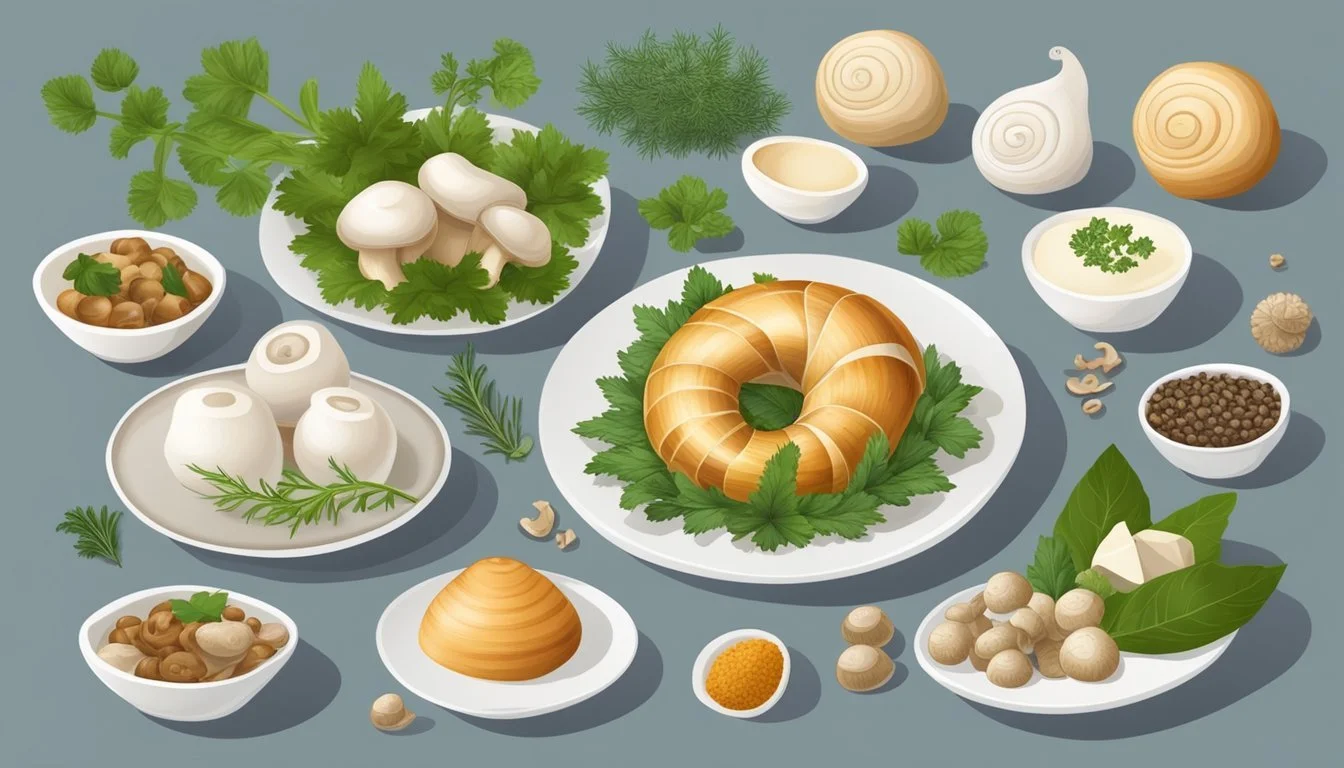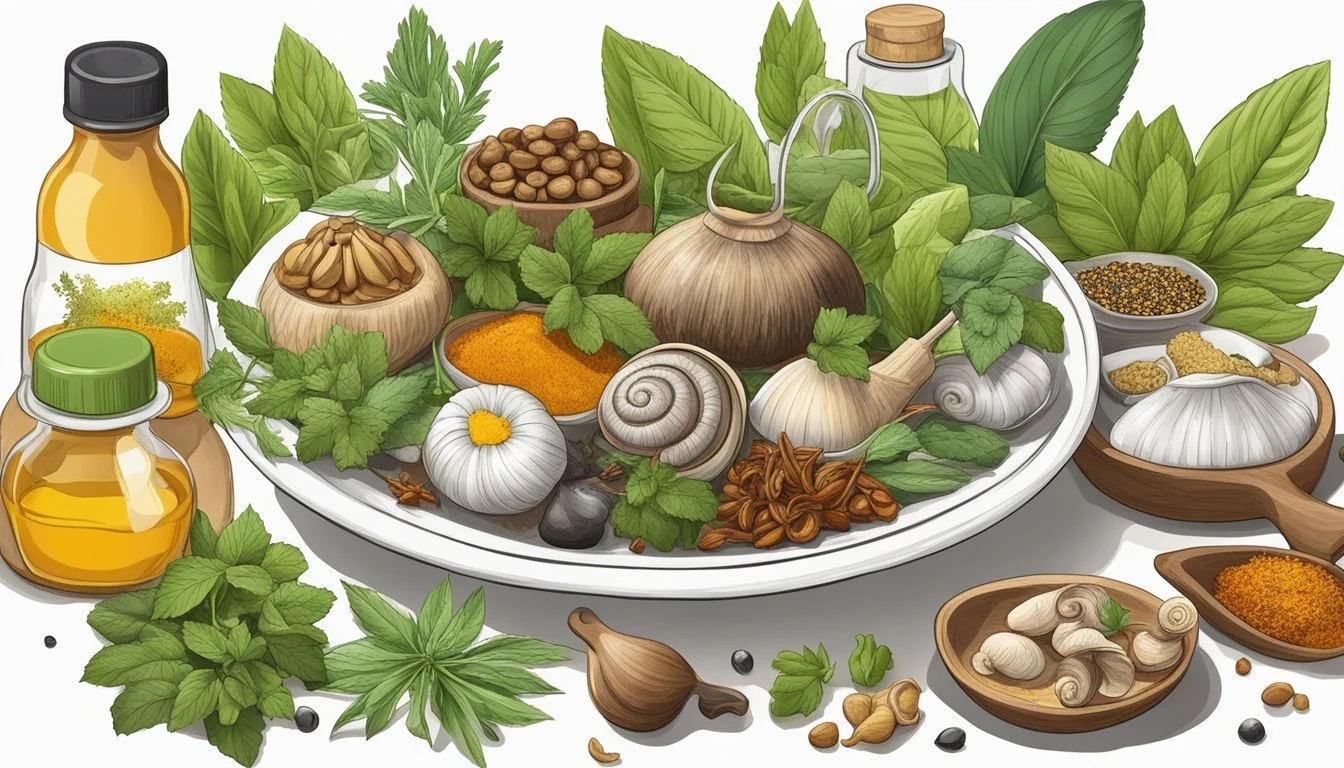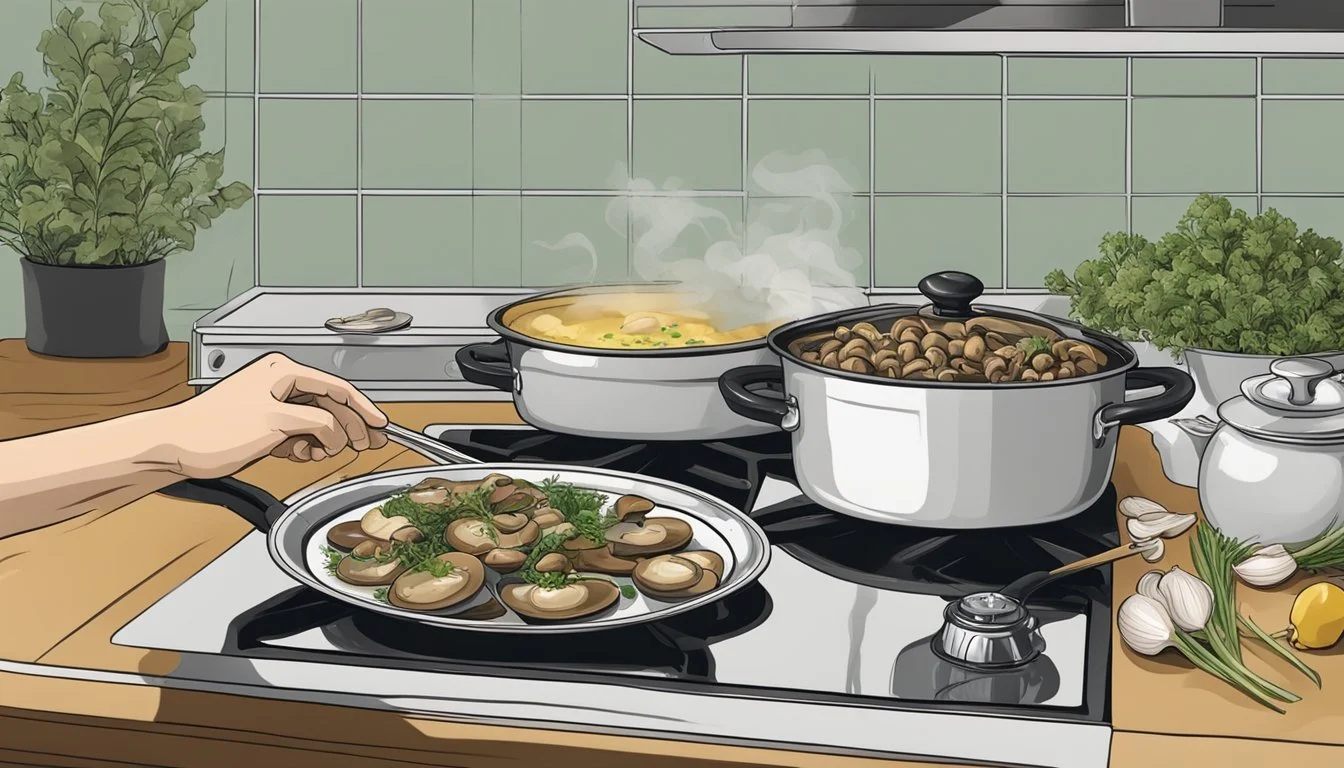Snail (escargot) Substitutes
Delicious Alternatives for Gourmet Dishes
When it comes to enjoying the delicacy of escargot, some may seek alternatives due to dietary preferences or local availability. Mushrooms serve as an excellent snail substitute, providing a similar texture and the capacity to absorb rich flavors. Preparing them with butter, garlic, and herbs can yield a dish that satisfies the craving for this classic French cuisine.
For those who prefer seafood, littleneck clams can provide a delightful variation. These clams, when cooked escargot-style with garlic butter, offer a familiar yet distinct taste experience. They mirror the indulgent flavors that make escargot a beloved appetizer.
In exploring different options, it's clear that the essence of escargot dishes can be captured by various substitutes. Whether utilizing mushrooms, clams, or experimenting with other ingredients, the focus remains on creating a flavorful and enjoyable culinary experience.
Overview of Escargot
Escargot, a delicacy in French cuisine, has a rich history and plays a significant role in cultural and culinary traditions. This section explores the historical significance of escargot and its place in French cuisine.
Historical Significance of Escargot
Escargot has been consumed since ancient times. Romans are known to have farmed and eaten snails, considering them a gourmet food. Archaeological evidence indicates that snails were a part of the diet across multiple European cultures.
In medieval France, snails became a valuable food source during Lent and other fasting periods when meat consumption was restricted. They were easy to farm and provided a protein-rich alternative. The practice of eating snails was passed through generations, becoming an integral part of French heritage.
During the 19th century, escargot gained prominence in French haute cuisine. Renowned chefs and restaurants began refining snail recipes, elevating them to the status of a luxury dish.
Escargot in French Cuisine
In modern French cuisine, escargot is synonymous with sophistication and indulgence. Typically, Helix pomatia (Burgundy snail), Helix aspersa, and Helix lucorum are the preferred species for their size and taste.
The traditional preparation involves cleaning and cooking the snails in a broth. Once cooked, they are typically served in their shells with a rich garlic and parsley butter. This classic method ensures a tender and flavorful dish.
Escargot is often associated with Burgundy, a region famous for its vineyards and gourmet food. Here, it is a staple in many restaurants and home kitchens, often served at festive occasions and as part of fine dining experiences.
French cuisine maintains a high standard for escargot dishes, emphasizing quality and presentation. The dish represents a blend of simplicity and elegance, making it a revered aspect of France's culinary landscape.
Understanding Snails as Food
Snails have been a food source since ancient times and are particularly popular in the Mediterranean, Africa, France, and Southeast Asia. This section explores their nutritional benefits, edible varieties, and methods of preparation.
Nutritional Value of Snails
Snails are a nutritious option, high in protein and low in fat. A 100-gram serving of cooked snails contains around 16 grams of protein and only 2 grams of fat. They also provide essential vitamins and minerals, including iron, magnesium, phosphorus, potassium, and vitamin B12. These nutrients contribute to maintaining energy levels, supporting muscle growth, and aiding various bodily functions.
Varieties of Edible Snails
Several species of snails are suitable for culinary purposes. The most popular include Helix pomatia (Roman snails) and Helix aspersa (garden snails). Helix pomatia is often preferred due to its large size and tender meat, making it ideal for dishes like escargot. Helix aspersa, smaller yet equally flavorful, is another common choice. Both species can be found in various regions, and their cultivation, known as heliciculture, is a specialized form of farming.
Snail Harvesting and Preparation
Proper preparation of snails is crucial to ensure they are safe and palatable. Harvesting typically involves collecting snails from gardens or farms. Before cooking, snails need to be rinsed thoroughly and purged to clear their digestive tract of any harmful substances. Purging involves feeding them a diet of safe, non-toxic food, or keeping them in a clean environment for several days. After purging, snails are often boiled, then cooked with herbs, garlic, and butter to create delicacies such as escargot.
Substitutes for Escargot
Finding substitutes for escargot can be driven by various factors such as availability, dietary preferences, or personal taste. Suitable alternatives should mimic the texture and flavor profile of escargot to provide a satisfying culinary experience.
Criteria for Selecting Alternatives
Choosing the right substitute involves looking at specific characteristics. Texture is paramount; alternatives should have a firm yet tender bite. Flavor is another critical aspect, as it should absorb and blend well with typical escargot seasonings such as garlic and butter. Additionally, availability and preparation ease are practical considerations that can influence the choice of substitute.
Mushroom as an Escargot Substitute
Mushrooms, specifically cremini or button mushrooms, are excellent escargot substitutes. Their texture is similar, providing that firm yet tender bite when cooked. Additionally, mushrooms are known for their ability to absorb flavors, making them ideal for the traditional garlic and butter preparation.
Preparation is straightforward. Clean and remove the stems, and cook the caps in a similar manner to escargot. Their flavor, while not identical, complements the seasonings well. These fungi are a popular choice due to their widespread availability and ease of preparation.
Other Seafood Alternatives
Seafood can also serve as an escargot substitute. Littleneck clams are a notable example, providing a similar texture and flavor profile when cooked in a garlic butter sauce. These clams should be scrubbed, cooked, and served in their shells to mimic the escargot presentation.
Another option is scallops, which have a slightly firmer texture but still absorb flavors well. Slice them into smaller pieces to better match the size and texture of escargot. Both these seafood alternatives offer a familiar yet distinct taste that enhances the dining experience.
Vegetable-Based Alternatives
For those seeking non-mushroom, non-seafood options, certain vegetables can work well. Zucchini and eggplant are notable for their ability to absorb flavors and maintain a satisfying texture when cooked.
Cut these vegetables into bite-sized portions and cook them in the same garlic butter sauce used for traditional escargot. They may not replicate the exact texture of snails, but they provide a pleasant and flavorful alternative, ideal for vegetarian diets.
Tables, lists, or any specific formatting can further illustrate these substitutes and their preparation steps, making the content more engaging and easier to follow.
Cooking with Escargot and Its Substitutes
Cooking with escargot involves classic ingredients like garlic and butter to enhance the snails' natural flavors. When using substitutes, it's essential to adapt recipes to maintain the desired taste and texture. Creative presentations can elevate the dining experience.
Preparing Escargot with Classic Ingredients
Escargot is traditionally cooked with ingredients that enhance its natural flavor. Garlic and butter are staples, often combined with parsley and shallots.
Garlic: Minced garlic is sautéed in butter to create a rich, aromatic base.
Butter: Softened butter helps to create a smooth, flavorful sauce.
Parsley: Freshly chopped parsley adds a burst of color and a fresh, herbaceous note.
Shallot: Finely minced shallots provide a mild, sweet onion flavor.
Wine: White wine adds acidity and depth.
These ingredients are often blended to form a garlic butter, which is placed over or within the snail shell and then baked.
Adapting Recipes for Snail Substitutes
When substituting escargot, the goal is to find alternatives that mimic the texture and ability to absorb flavors.
Mushrooms: Portobello or cremini mushrooms are popular substitutes. They offer a firm texture and can be cooked similarly to escargot.
Chicken: Small pieces of chicken breast can be used, benefiting from the same garlic butter flavors.
Eggplant: For a vegetarian option, eggplant slices can replace escargot. They absorb flavors well when properly prepared.
Preparation involves using the same classic ingredients—garlic, butter, parsley, and shallots—to ensure the dish retains its characteristic flavor.
Creative Presentation of Dishes
Presentation can transform a simple dish into a memorable experience. Using interesting plating techniques and garnishes can enhance the visual appeal.
Specialized Dishes: Traditional escargot dishes have dedicated slots for each snail, which can also be used for substitutes.
Pasta: Incorporating the prepared snails or substitutes into pasta dishes with wine and herbs can create a rich, cohesive meal.
Individual Portions: Serving in small, individual ramekins with a drizzle of flavored oil or thyme sprigs can make each bite feel special.
Creative presentation not only delights the eyes but also enhances the overall culinary experience.
Garnishes and Seasonings for Snails and Their Substitutes
Complementing snails and their substitutes with the right garnishes and seasonings enhances their flavor. Common additions include garlic butter, herbs like parsley, and spices such as pepper.
Herbs and Spices Compatibility
Garlic butter is essential and works well with most snail substitutes.
Chives add a mild onion flavor and pair excellently with snails or their alternatives, such as mushrooms.
Parsley provides a fresh contrast, enhancing the richness of the dish.
When seasoning, black pepper introduces a subtle heat and complexity.
Use a combination of chopped herbs like thyme, tarragon, or rosemary based on the substitute used to maintain harmony in flavor.
Tables can be useful:
Herb Compatible Substitute Chives Mushrooms, tofu Parsley Zucchini, artichoke hearts Thyme Eggplant, potatoes
Alternating garnishes and spices ensures the substitutes marry well with the classic snail flavors, providing a cohesive and satisfying dish.
Serving and Enjoying Escargot Dishes
To enjoy escargot dishes fully, attention to wine pairings and creating a complete dining experience is essential. Each element, from presentation to the choice of accompaniments, plays a crucial role in enhancing the taste and pleasure of the dish.
Wine Pairings with Escargot
Choosing the right wine can elevate the flavors of escargot. White wines like Chablis or Sancerre are classic choices, as their acidity complements the garlic-butter sauce often used in escargot à la Bourguignonne. For those who prefer red wine, a Pinot Noir can provide a light, flavorful pairing without overwhelming the dish.
Sparkling wines such as Champagne or Crémant offer a refreshing, effervescent contrast to the rich, buttery sauce. When serving escargot with herb and vegetable accompaniments, rosé wines can also be an excellent choice, bringing a fresh dimension to the overall taste.
Here is a quick guide to wine pairings:
Escargot Preparation Recommended Wine Pairing Classic Garlic Butter Sauce Chablis, Sancerre, Pinot Noir Herb Butter and Vegetables Rosé, Champagne, Crémant
Creating the Complete Dining Experience
The ambiance and presentation are just as important as the dish itself. Serving escargot on specialized dishes or small ramekins helps keep them warm and enhances the dining experience. Accompaniments like a warm, crusty baguette are essential for soaking up the flavorful sauce.
Adding a side of French brie can introduce a creamy contrast, adding depth to the meal. The setting should evoke a sense of French elegance, perhaps with soft lighting and classical music. A carefully set table with proper utensils and garnishes like fresh parsley can significantly enhance the dining experience.
Ensuring each element is thoughtfully prepared and presented creates a memorable escargot dining experience.
Acquiring Escargot and Alternatives
When sourcing escargot, quality matters. Whether opting for fresh or canned snails, understanding where and how to acquire them can make a significant difference.
Sourcing Quality Snails
Quality snails can be purchased from specialty gourmet stores or reputable online retailers. Fresh snails are often sourced from regions with a tradition of snail farming, such as France. It’s key to ensure the snails are purged and properly cleaned.
Local farmers markets may also offer fresh escargot. Always verify the source and the conditions in which the snails were kept. Live snails should show signs of activity, such as extending from their shells when moisture is present.
Cost considerations involve recognizing that fresh snails, especially those imported directly from another country, can be more expensive than canned options. Look for certifications or standards that indicate the snails were harvested and handled appropriately.
Options for Canned Escargot
Canned escargot offers a convenient alternative. They are pre-cooked and typically packed in either cans or jars. Sourcing canned snails from a trusted site can ensure quality.
French canned escargot brands, often regarded as premium, are widely available. They usually come in containers with the snails preserved in their own juices or a light brine. This preservation helps maintain taste and texture.
Other countries also produce quality canned escargot. For example, canned snails from Spain are gaining popularity. It's essential to check the label for any added preservatives or artificial flavors that might affect the quality.
Canned options are versatile and can easily be used in various recipes, making them an accessible choice for those looking to experiment with escargot cuisine.
Health and Safety Considerations
Ensuring that snails are cleaned and prepared properly is crucial. The nutritional benefits of escargots are numerous, but there are potential risks that must be managed carefully.
Cleaning and Preparing Snails Safely
Before consuming escargots, it is vital to clean them thoroughly. This involves purging the snails to remove any harmful substances from their digestive tracts. Commonly, they are fed cornmeal for a couple of days, which helps in eliminating any toxins and impurities.
After purging, the snails should be rinsed multiple times to remove any remaining slime. Following this, they need to be boiled or steamed briefly to kill any pathogens. Ensuring the snails are cooked at the correct temperature is essential to avoid foodborne illnesses. Utilizing proper kitchen hygiene and handling techniques can further minimize risks.
Potential Health Benefits and Risks
Escargots offer several nutritional benefits. They are a good source of protein, which is essential for muscle repair, and iron, which is crucial for blood production. Snails also contain beneficial amounts of fiber that aid digestive health.
On the flipside, there are health risks associated with escargots if they are not prepared properly. Snails can harbor parasites and bacteria, so thorough cleaning and cooking are vital. Additionally, individuals with shellfish allergies should avoid snails, as there can be cross-reactivity. Moderation is key, given their high cholesterol and sodium content.
Careful preparation and recognition of health risks ensure that you can enjoy escargots safely. Proper techniques and mindful consumption can allow the benefits to be enjoyed while minimizing the risks associated with this delicacy.
Culinary Techniques and Tips
Mastering the preparation of snail dishes requires specific techniques. For those looking to experiment with substitutes, it is crucial to adapt these techniques accordingly.
Mastering Snail-Based Dishes
When cooking snails, preparation is vital. Snails are typically purged, cleaned, and cooked with aromatic ingredients like garlic, shallots, and herbs.
Sautéing snails, a common method, involves cooking in butter and garlic until tender. Sauté the diced onion, mushroom stems, and garlic until soft.
For a classic garlic butter sauce, preheat the oven to 400°F (200°C), place a small amount of garlic butter in each escargot shell, add the snail, and bake for 10-12 minutes.
Tips for Cooking with Substitutes
Substitute snails, like mushrooms or shellfish, require different measures to achieve a similar texture and flavor. For example, remove mushroom stems, dice finely, and sauté with onions and garlic.
If using shellfish, keep cooking times shorter to avoid toughness. Opt for butter, garlic, and wine to enhance the flavor profile, similar to traditional snail dishes.
Preheating the oven and adequately seasoning substitutes can mimic the rich, buttery essence of escargot.
Seasonal and Regional Snail Dishes
Snail dishes offer a rich variety of flavors that vary by season and region. Various cultures incorporate these delicacies into their winter specialties, while others prepare them uniquely based on local traditions and ingredients.
Winter Specialties with Escargot
In French cuisine, escargot is particularly popular during the winter months. A notable dish is Escargots à la Bourguignonne, originating from Burgundy. This dish features snails baked with garlic butter, parsley, and shallots, often enjoyed during Christmas.
In Spain, snails make a festive appearance during winter celebrations. One such dish is Cargols a la Llauna, where snails are grilled in their shells with a touch of olive oil and seasoning, typically served with aioli.
California also sees an imaginative use of snails in winter menus, incorporating them into gourmet dishes that highlight local produce. Winter dishes often embellish snails with seasonal herbs and roasted vegetables, providing a warm contrast to the chilly weather.
Regional Variations in Snail Preparation
French regions each boast their own snail delicacies. Escargots de Bourgogne from Burgundy is famous for its butter and garlic preparation. In contrast, in Lorraine, Escargots à la Lorraine are cooked with wine, bacon, and onions, offering a heartier flavor.
Spanish snail dishes exhibit diverse preparation methods. Besides Cargols a la Llauna, in Andalusia, snails are simmered in spicy, tomato-based stews, reflecting the region's preference for bold spices.
California chefs often experiment with international influences, preparing snails in ways inspired by French and Spanish cuisines. Whether broiled with garlic and herbs or simmered in a saffron-infused broth, these regional takes highlight local culinary creativity.










